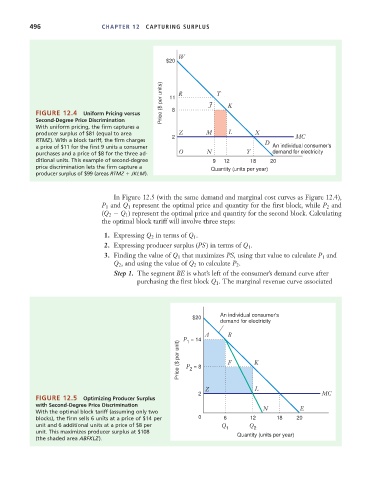Page 522 - Microeconomics, Fourth Edition
P. 522
c12capturingsurplus.qxd 7/22/10 10:41 AM Page 496
496 CHAPTER 12 CAPTURING SURPLUS
$20 W
Price ($ per units) 11 R J T K
FIGURE 12.4 Uniform Pricing versus 8
Second-Degree Price Discrimination
With uniform pricing, the firm captures a
producer surplus of $81 (equal to area 2 Z M L X
RTMZ). With a block tariff, the firm charges MC
a price of $11 for the first 9 units a consumer D An individual consumer's
purchases and a price of $8 for the three ad- O N Y demand for electricity
ditional units. This example of second-degree 9 12 18 20
price discrimination lets the firm capture a Quantity (units per year)
producer surplus of $99 (areas RTMZ JKLM).
In Figure 12.5 (with the same demand and marginal cost curves as Figure 12.4),
P and Q represent the optimal price and quantity for the first block, while P and
1
1
2
(Q Q ) represent the optimal price and quantity for the second block. Calculating
2
1
the optimal block tariff will involve three steps:
1. Expressing Q in terms of Q .
2
1
2. Expressing producer surplus (PS) in terms of Q .
1
3. Finding the value of Q that maximizes PS, using that value to calculate P and
1
1
Q , and using the value of Q to calculate P .
2
2
2
Step 1. The segment BE is what’s left of the consumer’s demand curve after
purchasing the first block Q . The marginal revenue curve associated
1
An individual consumer's
$20
demand for electricity
A B
P = 14
1
Price ($ per unit) P = 8 F K
2
L
Z
2 MC
FIGURE 12.5 Optimizing Producer Surplus
with Second-Degree Price Discrimination
With the optimal block tariff (assuming only two N E
blocks), the firm sells 6 units at a price of $14 per 0 6 12 18 20
unit and 6 additional units at a price of $8 per
Q 1 Q 2
unit. This maximizes producer surplus at $108 Quantity (units per year)
(the shaded area ABFKLZ).

